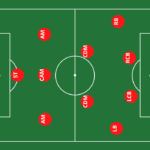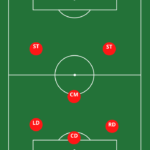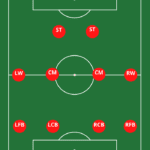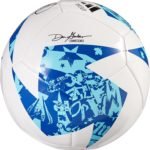- Last Updated -
What position in soccer is the best to play?
Soccer is a sport that requires all players to be actively involved in the game, but every player has a different role on the field.
There are various soccer field positions, each with its own set of responsibilities, duties, and required skills. With so many options available, it can be difficult to determine which position is the best for someone to play.
The first factor to consider when deciding on the best position in soccer is one’s natural abilities and physical attributes. For instance, if someone has great reflexes and quick movements, they might be well-suited for a goalkeeper position.
On the other hand, someone who possesses excellent dribbling skills and can run up and down the field quickly might make an ideal winger or striker. Another consideration is the game strategy and tactics of one’s team.
Soccer formation determines how many players are positioned in each section of the field (defense, midfield, or attack) and how they work together as a team. The coach usually sets out each player’s specific duties within this framework based on their position on the field.
The goalkeeper is often seen as one of the most important positions in soccer. A strong keeper can make a significant difference for their team by preventing goals from being scored.
Their primary duty requires them to defend their goal area by making saves with hands or feet while communicating effectively with their defense line.
The center-backs also play an essential role in protecting their team’s goal area since they are typically assigned to stop opposition attackers from advancing towards their goal area.
They should be diligent in tackling attackers while preventing them from scoring goals but also have good ball control skills that allow them to bring forward passes into midfielders.
Ultimately there is no “best” soccer position since every player brings something unique to his/her role within a given team structure; however certain roles such as central midfielder require high technical proficiency combined with high stamina levels which may not suit all player’s skillsets or lifestyles outside of the game.
What Are the Most Important Positions In Soccer
When talking about the most important positions in soccer, there are a few that immediately come to mind. These positions act as the backbone of any team and are crucial to ensuring the success of a team on the field.
One of the first positions that comes to mind is the goalkeeper. This position, often described as thankless, requires an immense amount of skill and awareness.
A goalkeeper’s primary duty is to protect their team’s goal and prevent the opposing team from scoring. They must be able to react quickly and make split-second decisions when faced with a shot on goal.
Additionally, they need strong communication skills as they serve as an extra set of eyes for their defense. Another crucial position in soccer is that of a center-back or central defender.
This position requires players who are physically strong, quick, and decisive. Centrebacks are responsible for preventing attacking players from advancing toward their goal by intercepting passes or making tackles.
They must also be good at reading the game and anticipating where their opponents will go next. Regarding midfield play, central midfielders have perhaps one of the most challenging roles on a soccer field.
They need to be versatile enough to contribute both offensively and defensively while controlling possession in midfield areas. Central midfielders often act as playmakers for their teams by setting up goals through creative passing or dribbling plays while also working hard defensively.
Strikers or forwards are essential positions in soccer because they’re responsible for scoring goals which ultimately determine whether a team wins or loses a match. Strikers work tirelessly to create opportunities for themselves and their teammates by finding space behind defenders or using speed and agility to run past them.
Overall, each position in soccer plays an integral role in determining how successful a team will be on the field.
Understanding each player’s duties within these positions is key not only for individual player development but also for ensuring proper chemistry among teammates when implementing different formations, strategies, and tactics.
Goalkeeper
The goalkeeper is arguably the most crucial position on the soccer field.
The goalkeeper is responsible for preventing the opposition from scoring, and they are usually the last line of defense. The goalkeeper is often referred to as a team’s “safety net,” as they are always there to bail out their teammates in case of mistakes or defensive lapses.
In terms of soccer player duties, the goalkeeper has a unique set of responsibilities that differentiate them from other positions. Unlike other players, who are constantly on the move and involved in various aspects of gameplay, goalkeepers have to be patient and wait for their chances to make an impact.
Goalkeepers must also be vocal leaders on the field, as they have a clear view of everything that’s happening and can give direction to their teammates accordingly. In terms of soccer formation, goalkeepers are usually positioned at the back of a team’s formation.
They occupy a fixed position between two posts and try to protect their goal area from incoming shots or crosses. This means that they need to have excellent reflexes and great hand-eye coordination to stop balls that come flying at them at high speeds.
When it comes to soccer strategy, many teams choose to build their defenses around their goalkeeper. A strong goalkeeper allows teams to take more risks going forward knowing that if anything goes wrong defensively, they have someone reliable guarding their goalpost.
Being a goalkeeper is no easy task – it requires immense concentration, excellent reflexes, and outstanding leadership skills. Despite this pressure-filled role though, some players thrive in it because it offers them the best chance for glory when things go right – or saves them from total disaster when things go wrong!
Centre Back
Centre Back is a crucial soccer position that requires physicality, technical skills, and excellent decision-making abilities. The center-back plays in the heart of the defense and is responsible for protecting the goalkeeper from opponents’ attacks.
This position requires players to have a strong sense of positional awareness, as they must constantly monitor the opposing team’s movements and anticipate their next moves. One of the main duties of center-backs is organizing their defensive line to create an impenetrable wall.
They must communicate with their teammates to ensure they are marking their assigned opponents and covering any gaps in the defense. It’s also crucial for center-backs to remain calm under pressure and make quick decisions when defending against counter-attacks.
Another critical role of center-backs is initiating counter-attacks from defense. The best center-backs are not only solid defenders but also excellent passers who can start attacking moves from deep within their half.
They must have technical proficiency in passing, dribbling, and shooting to effectively contribute to both offense and defense. In terms of physicality, center-backs are often some of the tallest players on the field due to their need to win aerial duels against opposing forwards.
They must also be robust enough to withstand physical challenges from attackers without conceding fouls or penalties. Overall, a successful soccer team cannot function well without reliable Centerbacks on its roster.
Their strategic placement in defense helps keep opponents at bay while providing an offensive push when necessary. As such, top-performing Centerbacks possess an all-around skill set that includes good communication skills, endurance levels equal to or surpassing other team members, high soccer IQ combined with speed plus analytical thinking capability during playtime – these attributes all combine into creating a successful defender specialized for this vital soccer position.
Central Midfield
Central midfield is arguably the most important position in soccer. It’s a position that requires immense skill, stamina, vision, and leadership. Players who occupy this area are responsible for controlling the game’s tempo and dictating the play.
They continuously run up and down the field to cover both defensive and attacking duties. In terms of soccer formation, central midfielders often play a crucial role in linking the defense to the attack as they collect passes from defenders and then distribute them to forwards or wide-area players.
Their ability to anticipate opponents’ moves while maintaining awareness of their teammates’ positions makes them stand out on the field. When it comes to soccer player duties, central midfielders are expected to be versatile players who can switch between offense and defense seamlessly.
They must possess excellent ball control skills as they’re often required to dribble past opponents while also being able to make accurate passes. In terms of soccer team structure, central midfielders play an important role in forming a solid spine for their teams.
They’re often seen as the glue that holds all other positions together. For instance, when playing with a defensive midfielder behind them or an attacking midfielder ahead of them, they must strike a balance between covering for each other defensively while also providing key passes going forward.
In soccer tactics, central midfielders are essential when it comes to pressing opponents high up on the field or dropping back defensively when under pressure from an opponent’s counter-attack.
Central midfielders can be instructed by coaches on how best to approach different tactical situations during games such as how deep they should sit back or whether they should be used more offensively than defensively.
Every successful team needs strong central midfield players because of their ability to manage games both offensively and defensively effectively. Their contributions are critical for any team looking for success on the field no matter what formation is used or which tactics are employed during gameplay.
Striker
The striker is undoubtedly one of the most essential positions in soccer. They are responsible for scoring goals, which ultimately determines the outcome of a game.
Strikers are typically positioned at the front of the team’s formation and have a variety of duties on the field. The position requires players to possess exceptional ball control, speed, agility, and strength.
One of the critical duties of a striker is to score goals. They must be able to find openings in the opposing team’s defense and take advantage of them.
Strikers often have an excellent sense of positioning, allowing them to be in the right place at the right time to receive a pass or make a shot on goal. Their success depends on their ability to stay focused and make quick decisions.
Another important aspect of playing as a striker is teamwork. While strikers are often known for their goalscoring abilities, they must also work closely with their teammates to create scoring opportunities.
This means effectively communicating with other players on the field, understanding soccer formation and tactics, anticipating movements and passes from teammates, and being able to read an opposing team’s defense. Physical attributes such as speed and strength are also crucial for playing as a striker.
A fast player can break away from defenders more easily while strength allows them to hold off defenders when receiving passes or making shots on goal. They must be able to respond quickly during games because they will typically face aggressive challenges from opposing teams trying to prevent scoring opportunities.
Being a successful striker requires excellent ball control skills alongside physical capabilities such as speed and strength.
Players in this position should also have excellent teamwork skills alongside good communication abilities with their teammates both during training sessions or actual soccer games; understanding soccer formation and tactics will go further in helping strikers increase their chances of creating scoring opportunities on behalf of themselves or their team while ultimately contributing positively towards overall team performance.
What are the 4 main positions in soccer?
Soccer is a game that consists of four main positions. These four positions are necessary for any soccer team as they form the foundation of the game. The four basic positions in soccer are the goalkeeper, defender, midfielder, and forward.
Each position has its own unique set of responsibilities and duties on the field. The goalkeeper is one of the most important players on a soccer team.
They are responsible for guarding their team’s goalpost and making sure that no goals are scored against them. The goalkeeper must be agile and quick with their reflexes to save shots on goal.
Additionally, they must have good communication skills as they direct their defense to block shots. Defenders are responsible for keeping their side of the field free from attacking players from the opposing team.
They form a wall between the opposing team’s forwards and midfielders by blocking shots, clearing balls out of danger zones, and making tackles to regain possession of the ball. Defenders must also be able to anticipate their opposition’s moves and react quickly to prevent them from scoring.
Midfielders play an essential role in controlling a game’s pace by dictating play in both offense and defense zones; they have significant contributions in both areas. Midfielders move back and forth between attack mode (by pushing forward) or defensive mode (by dropping back), depending on where control over possession lies at any point in time during a game.
Forward players provide an offensive threat by playing near or at their opponent’s goal area. They take advantage of gaps left behind by defenders within their opponent’s zone while trying to score goals themselves or create opportunities for teammates who may be nearby for easier finishes on goal-scoring chances.
Understanding each position’s roles in soccer is crucial when trying to comprehend how teams function together strategically during matches while changing formation depending on several factors such as opponents’ strengths/weaknesses or match situation dynamics.
Mastering these roles enables players with a more profound understanding of the game and an appreciation for their team’s tactics and strategies.
Goalkeeper
The goalkeeper position is one of the most important positions in soccer. Often called the last line of defense, the goalkeeper’s role is to prevent the opposing team from scoring by stopping shots on goal, commanding their defense, and distributing the ball to start counter-attacks.
The goalkeeper has a unique set of skills and duties that differ significantly from other positions on the field. One of the most crucial duties of a goalkeeper is shot-stopping.
They must be quick to react to shots on goal and have excellent reflexes to make saves. Shot-stopping requires good positioning and awareness of where players are on the field.
A goalkeeper must also have excellent hand-eye coordination and be able to jump high to reach high shots. Another key responsibility of a goalkeeper is commanding their defense.
They are responsible for organizing their team’s defensive structure and positioning, ensuring that they cover all areas effectively. A good goalkeeper should be vocal and communicate well with their teammates throughout the game.
Distribution is another essential aspect of a keeper’s responsibility. They are often responsible for starting counter-attacks by distributing passes quickly and accurately upfield after making a save or receiving possession from their teammates.
A keeper needs good footwork as well as great passing skills to execute these long-range passes. Goalkeepers need to understand different soccer formations, strategies, and tactics used by both teams in a game situation since they may need to make adjustments quickly based on how an opponent attacks or defends against them.
Therefore, they need excellent tactical awareness and game intelligence. Being a good goalkeeper requires several unique skill sets that differentiate this position from others on the field because it requires great shot-stopping abilities while also having excellent leadership skills when organizing team defenses or starting counter-attacks with accurate distribution abilities along with tactical knowledge about different formations used in games situations that call upon them at any moment during playtime – all necessary qualities for success at this position!
Defender
Defenders are an essential part of any soccer team’s strategy. Their primary duty is to prevent the opponent from scoring goals and protect their goal post.
They play a vital role in defending set-pieces, blocking shots, marking opponents, and clearing the ball out of their half. Defenders must possess excellent physical attributes such as strength, speed, agility, and height to effectively execute their duties.
In a standard soccer formation, four defenders usually make up the backline – two center-backs and two fullbacks. The center-backs are typically strong and tall players who can win aerial duels and defend against long balls.
On the other hand, fullbacks are more agile and often tasked with overlapping runs on the wings to provide width in attack while still providing solid defensive cover. The primary role of defenders is to form the last line of defense before goalkeepers in a typical soccer team structure.
They must be aware of their positions on the field at all times to prevent offside traps or leave gaps that opponents can exploit. Good communication among defenders is crucial for effective defensive teamwork as they must work together seamlessly to defend against opposing attackers.
Defensive tactics vary based on different game situations; however, one essential feature is man-to-man marking where each defender marks a particular opponent closely throughout the game’s duration. Defenders also work in coordination with midfielders when pressing high up the field or preventing counterattacks.
Defenders play a critical role in any soccer team’s success by securing clean sheets and preventing opposition goal-scoring opportunities. Their technical ability combined with physical prowess makes them important contributors both in defense and attack for teams that use overlapping fullbacks effectively during games.
Midfielder
When it comes to the most skilled position in soccer, most experts agree that the midfielder takes the cake. Midfielders play a crucial role in any team’s strategy and structure, and they are often referred to as the “engine room” of the team.
They are typically positioned in the center of the field, tasked with both defending their own goal and manufacturing offensive plays. One key trait that all great midfielders have is stamina.
They need to be able to cover a lot of ground during a game, both defensively and offensively. Midfielders must be able to run back quickly when their team loses possession but then sprint forward again when their team regains control of the ball.
This requires not only physical fitness but also mental endurance. Another essential quality for midfielders is leadership.
They are often responsible for directing their teammates on the field, telling them where they should be positioned and what tactical adjustments they need to make. A good midfielder will constantly communicate with other players during a game and make sure everyone is on the same page.
Technical skills are also critical for successful midfield play. Midfielders need excellent ball control, passing accuracy, and vision – they must be able to spot openings in opposition defenses quickly and move into those spaces themselves or pass accurately through them.
Many times goals come about because of great passes from midfield players who can see patterns triangulating around defenders who can’t track every movement. High soccer IQ is crucial for midfield success at all levels of competition from amateur through professional leagues (and even international teams).
Being able to read any situation on the field quickly could mean identifying an open space or making last-moment tackles before letting someone else go solo toward your own goal area undefended. Overall, being a midfielder isn’t an easy task but if you have talent plus these qualities; you will surely excel at this position!
Forward
When it comes to scoring goals, the forward is the key player on any soccer team. This is a position that requires strong physical and technical abilities, as well as great strategic thinking.
The main duty of a forward is to score goals, but they also need to be able to create chances for their teammates and maintain possession of the ball under pressure. In terms of team structure, forwards are typically positioned in the front line of attack alongside midfielders or wingers.
They rely heavily on their speed and agility to get past defenders and create opportunities for themselves and their teammates. This requires quick decision-making skills and an ability to read the field well.
Soccer game positions are important for forwards because they need to be positioned in areas where they can receive passes from midfielders or wings. They also need to be aware of defensive players who can block their shots or intercept passes intended for them.
Because of this, forwards need excellent ball control skills so that they can maneuver around defenders with ease. Soccer tactics play a crucial role in determining how a forward operates during games.
Depending on the formation used by a team, forwards may be asked to play different roles. For example, in a 4-4-2 formation with two attacking midfielders behind them, forwards might spend more time making runs into space rather than trying to hold up play and bring others into the game.
Soccer field positions are also important for understanding how forwards work within their teams. Some teams prefer using only one striker at a time while others use two strikers playing off each other as part of an attacking partnership.
In either case, forwards must be able to adapt quickly depending on the situation unfolding on the field. Being a forward is one of the most exciting roles in soccer because it offers players numerous opportunities to make an impact on games by scoring goals or setting up chances for others.
To succeed as a forward requires top-notch technical abilities, quick decision-making skills, and a strong strategic mindset. Forwards are the driving force behind any successful soccer team and are crucial to achieving success both on and off the field.
What is the most skilled position in soccer?
When it comes to soccer, there are a variety of positions that each require their own unique set of skills. However, one position stands out as the most skilled – the midfielder.
This position is often referred to as the “engine room” of a team, responsible for both attacking and defensive duties throughout the game. Firstly, midfielders require exceptional stamina to cover vast amounts of ground during matches.
They must be able to run tirelessly from box to box, breaking up opposition attacks and creating chances for their team. Along with stamina, they must possess excellent technical skills such as dribbling, passing, and shooting to control the ball and create opportunities for themselves and others on the field.
In addition to physical attributes and technical ability, midfielders must also possess high soccer IQ and tactical awareness. They need to be able to read the game well to anticipate opposition plays while also being creative enough to make their own attacking moves.
A good midfielder will know how much pressure they can apply before making a tackle or interception without giving away a foul or losing possession. Leadership is an essential skill for any midfielder.
They need to have strong communication skills to direct their teammates around on the field. Additionally, they should be confident enough in themselves as players that they are willing to take charge when needed – whether it’s giving instruction or taking control during tense moments.
Overall, being a midfielder requires a combination of physical fitness, technical ability, soccer IQ/tactical awareness, and leadership skills on top of other typical soccer player duties.
is no wonder that this position is considered by many coaches and fans as the most skilled position in soccer due to its complexity within Soccer game positions, Soccer tactics, Soccer team structure, Soccer field positions, Soccer strategy , and Soccer formation compared with other positions on the field like defenders or strikers who have more specific roles in gameplay.
The Midfielder
The midfielder is considered by many experts to be the most skilled position in soccer. This player is responsible for linking the defense to the attack and must possess a unique mix of physical, technical, and tactical skills. The midfielder plays a critical role in determining the tempo of the game and controlling possession.
In this section, we will discuss why midfielders are so valuable and explore some of the essential skills that all great midfielders have. Stamina: One of the most important attributes of a midfielder is endurance.
These players must be able to run up and down the field for 90 minutes or more while maintaining their technical abilities and tactical awareness. It’s not unusual for high-level midfielders to cover over 10 kilometers during a single game.
They must also be able to recover quickly from sprints, allowing them to close down opponents or create space with ease. Leadership: Great midfielders are not only technically gifted but also have excellent leadership qualities.
They must communicate effectively with teammates both on and off the ball, often serving as a bridge between defense and attack. A good midfielder can read the game well, anticipate opponents’ moves, adjust their team’s tactics accordingly, and motivate teammates when necessary.
Technical skills: Midfielders need excellent ball control techniques as they are often under pressure from opposing players when receiving passes from defenders or strikers alike; they need an agile first touch that allows them to turn quickly away from pressure without losing possession.
They also require exceptional passing accuracy at short- or long-range distances as well as dribbling ability that allows them to evade defenders while moving forward with possession.
High soccer IQ: Finally, great midfielders possess high soccer IQs which permit them to process information quickly during games such as analysis of opponent formation changes & weaknesses; they know when it’s appropriate for them to make crucial tackles versus maintain shape (in defense) or launch probing attacks (in attack).
They require an eye for detail, quick decision-making skills, and the ability to spot gaps and create chances for teammates.
Midfielders are the most vital position on a soccer field. They link the defense to the attack and control the game’s tempo by maintaining possession of the ball.
They must be physically fit, technically sound, possess excellent leadership qualities, and have high soccer IQs. It takes a special player to excel in this position, but when they do, they become essential components in any successful soccer team structure.
Skills That All Great Midfielders Have
Midfielders are perhaps the most versatile and dynamic players in soccer, and great midfielders have several skills that set them apart from others on the pitch. One such skill is stamina.
Midfielders must be in top physical condition to keep up with the pace of a game and provide support for both defense and offense. They run an average of 10-12 km per game, so they need superior endurance.
Another essential quality of a great midfielder is leadership. Midfielders are typically positioned at the center of the field, acting as conduits between defense and offense.
As such, they must possess strong leadership qualities to direct play and motivate their teammates throughout the match. Technical skills are also critical for midfielders.
They must have excellent ball control, passing accuracy, dribbling ability, and shooting proficiency to set up plays or score goals. These skills require constant practice in passing drills, dribbling drills, and shooting drills which will enhance their technical ability.
Great midfielders have high soccer IQs. They must be able to read the game well by anticipating opponents’ moves accurately while making quick decisions based on what’s ahead like reading through opposing teams’ formation patterns to gain an advantage over them during gameplay.
In general terms being a midfielder is one of the most demanding positions in soccer which requires a lot of hard work both physically and mentally. Successful midfielders need not only excellent fitness but also exceptional ball control technique combined with creativity as they are responsible for controlling play across all areas of the pitch.
Midfielders must possess several essential skills if they’re to excel in that position. Stamina enables them to maintain high levels of fitness throughout games; leadership qualities help guide their team through challenging situations;
technical skill allows them to execute complex maneuvers with ease while having a high soccer IQ helps one make quick decisions that can improve their team’s chances of scoring or defending effectively thereby enhancing overall team performance.
Stamina
Stamina is an essential trait for any soccer player, regardless of their position on the field. Without adequate stamina, players will struggle to maintain their performance levels throughout the game. In soccer, games can last up to 90 minutes, which is a physically demanding length of time that requires a player to be in excellent physical condition.
Endurance training is an integral part of any soccer player’s training regime and can help players build the necessary stamina to play at their best. In terms of soccer positions, some require more stamina than others.
For example, midfielders have to cover more ground than any other position on the field and are therefore required to have excellent stamina. They must run up and down the field constantly and often need to make quick bursts of energy when pressing or tackling opponents.
Defenders also require a high level of stamina as they are responsible for covering large areas on the pitch and tracking attacking players who may try to make runs behind them. They have to be alert at all times and able to react quickly if an opponent manages to get past them.
Forwards also need good stamina as they are expected to constantly make runs into open spaces to receive passes from their teammates or create scoring opportunities for themselves. A forward who lacks stamina may struggle with keeping up with play or making these vital runs into space.
Goalkeepers typically do not require quite as much stamina as other positions since they don’t spend nearly as much time running around the field during a game. However, good goalkeepers still need adequate endurance since they must be ready at all times for sudden bursts of action when called upon.
Overall, endurance training should form an integral part of every soccer player’s training regime regardless of position since it is such an important aspect of the game. With proper preparation, players can build their endurance levels over time and ensure that they perform at their best for the full duration of each match.
Leadership
Leadership is a crucial aspect of soccer, particularly in team sports. A team can have the best soccer formation and tactics, but without proper leadership on and off the pitch, it can be challenging to achieve success.
The importance of leadership extends beyond just the captain of the team and affects every player on the field. One of the most prominent aspects of leadership is setting an example for others to follow.
The captain must be a role model for other players, showing them how to play with integrity and respect for their teammates and opponents. They must also be committed to working hard both on and off the field and make sure that they are always giving their best effort.
Another essential aspect of leadership is communication. Effective communication helps establish a strong connection between players on the field, enabling them to work together more effectively as a team.
The captain must communicate with other players about their roles and responsibilities in different soccer formations when playing in different soccer game positions. Leadership also involves motivating others to perform at their best level possible while ensuring that everyone stays focused on the task at hand.
This requires strong motivational skills that can help rally teammates behind a common goal or objective. A leader should also be accountable for their actions.
Whether they succeed or fail while playing in different soccer positions or when using different soccer strategies, leaders must take responsibility for their decisions and actions while holding themselves accountable for any outcomes. Leadership plays a critical role in soccer teams’ success because it sets an example for all players on how they should behave on- as well as off-the-field;
communicate effectively with teammates about tactics & strategy; motivate others when things get tough; remain focused throughout gameplay by providing clear guidance during tense moments; hold themselves accountable no matter what happens during gameplay – which ultimately leads to stronger teamwork overall!
Technical skills
Technical skills are essential to all soccer positions, regardless of whether you are a goalkeeper, defender, midfielder, or striker. These skills relate to the ability to control the ball and pass it accurately, as well as being able to shoot with precision and power. Technical skills include dribbling, first touch, passing accuracy and vision, ball control in tight spaces, and aerial control.
Dribbling is a crucial technical skill that allows players to move quickly with the ball while maintaining control. It is an important skill for attackers who need to take on defenders one-on-one and create scoring opportunities.
Dribbling requires good footwork and balance while maintaining awareness of other players around you on the field. The first touch is the ability to receive the ball and immediately bring it under control in one fluid motion.
This skill is essential for all players as it allows them to quickly transition from defense to attack or vice versa. A good first touch helps maximize possession for your team while minimizing turnovers.
Passing accuracy and vision are other critical technical skills required in soccer. Players should be able to make short passes between teammates accurately as well as long passes that split opposing defenses or switch the point of attack.
Good vision means anticipating where teammates will be moving so that passes can be delivered accurately into their path. Ball control in tight spaces involves keeping possession of the ball even when under pressure from defenders with limited space available around you on the field.
This involves having quick feet, excellent balance, and being able to shield off opponents while maintaining possession. Aerial control refers specifically to controlling balls that are crossed into the penalty area from either side of the pitch via a corner kick or free-kick by heading them towards the goal or knocking them down for other teammates through accurate flicks or volleys.
The technique requires players’ high jump strength along with proper positioning based on the Soccer formation used by their team structure within Soccer field positions. Overall these technical skills require repeated training until they become second nature to a player, enhancing his ability to perform better in Soccer game positions with high intensity.
High soccer IQ
A high soccer IQ refers to a player’s ability to make quick decisions on the field. A player with a high soccer IQ is always thinking ahead of the play and can anticipate where the ball will be.
This skill makes them an important asset to their team, especially in crucial moments of the game. To have a high soccer IQ, players must be knowledgeable about soccer formation, tactics, and strategy and understand their position and role on the team.
Understanding soccer formation is one way to develop a high soccer IQ. Players who understand how formations work can look at the game from multiple angles and better anticipate where they need to be on the field.
This is especially important for midfielders who need to read the game well and move quickly from defense to offense. Players with a high soccer IQ also need to understand their specific role in their team’s tactics and strategy.
A striker needs to know when they should press high up the field or drop deeper into midfield areas while a midfielder must understand when it’s time for them to drop into defense or push forward towards attack. Another crucial feature of players with high soccer IQ is that they maintain good positional discipline throughout the game.
A player who keeps drifting out of position can create gaps in their team’s formation, leaving opponents free spaces to exploit. Players with a high soccer IQ are essential assets for any successful team because they can think through complex situations quickly and adapt accordingly.
They see plays unfolding before them so that they know what positions will allow them easy access or stoppage of passes between players as part of their Soccer player duties.
To acquire this ability takes practice along with continuous development of tactical awareness skills within matches played on Soccer field positions over time through diligent training sessions under guidance from quality coaches who have experience in this area of expertise.
What’s the most popular position in soccer?
What’s the most popular position in soccer? Soccer is a sport loved by millions of people around the world, and although it requires teamwork, each player has a specific role to play.
Soccer game positions vary depending on the team’s strategy and formation. The most popular position in soccer is forward or striker.
Strikers are responsible for scoring goals, and they are often regarded as the most glamorous players on the field. A forward’s primary duty is to score goals with their feet or head.
They must also be skilled at creating opportunities for other attackers by passing and dribbling past defenders. A striker’s role is demanding but rewarding, as they are often recognized for their goal-scoring abilities.
Another popular position in soccer is midfielder, who plays an essential role in controlling the flow of the game. Midfielders must be versatile players who can both defend and attack equally well.
They are responsible for linking defenders and attackers on a team, making interceptions to slow down opponents’ attacks while setting up their own team’s attacks. Defenders are other critical player in soccer game positions who help protect their goalkeeper from opponent strikers’ shots on goal.
Defenders must have excellent tackling skills while maintaining good positioning to prevent attackers from getting past them easily. Goalkeepers are perhaps one of the most underrated positions in soccer since they often receive less credit than other players despite playing an essential role in ensuring a team’s success.
The goalkeeper’s primary responsibility is to keep their team from conceding goals by making saves with various parts of their body like feet, hands, or chest. While forwards may be considered as glamorous players due to their goal-scoring prowess, midfielders play an equally important role in helping connect defense with attack while defending themselves at times too.
Defenders help protect against opposition attacks just like Goalkeepers who ensure that none of those opposition attacks result in conceding a goal by saving shots at them even when diving along the horizontal axis. Each position in the game of soccer has its unique responsibilities and contributions, making it vital for every player to understand their role and work together as a team to achieve success.
Most fun position in soccer?
Most fun position in soccer? One of the things that make soccer a beautiful game is the fact that everyone can find enjoyment in playing in their preferred positions. However, some positions tend to be more engaging and thrilling to play than others.
Here are some of the most fun positions in soccer. Winger – This position is all about speed and skill.
As a winger, your primary role is to take on defenders and create scoring opportunities for your team. You have the freedom to roam around the flanks, dribble past opponents, and cross balls into the box.
Wingers are usually agile players with great ball control, who can change direction quickly while maintaining top speed. Attacking midfielder – Another exciting position on the pitch is that of an attacking midfielder.
The role of an attacking midfielder is to create chances for strikers by providing them with accurate passes or scoring goals from midfield. The beauty of this position lies in its versatility- you can operate as a central attacking midfielder or as a wide playmaker depending on your team’s formation.
Attacking midfielders need excellent vision, passing range, shooting accuracy, and dribbling skills. Forward – Scoring goals is undoubtedly one of the most satisfying feelings in soccer, which makes playing as a forward one of the most enjoyable positions on the field.
You get to be at the front line of your team’s attack and have several chances to put that ball at the back of the net each game day. Forward players should have great finishing skills, agility, strength, and positioning sense among other traits concerning their style.
Goalkeeper – While playing goalkeeper might not seem like it would be fun at first glance considering all the pressure from being last-line defense it’s fun! Being able to make crucial saves and keep your team in games is an incredibly satisfying feeling for many players who love challenges like these!
Goalkeeping requires quick reflexes, good decision-making skills under pressure, leadership qualities great communication with defense, and perfect diving skills. Overall, soccer is a game that offers enjoyment in various positions.
Each position has its unique duties, challenges, and rewards. Choosing the most fun position depends on your playing style, skills, and personality.
Final Thoughts on what is the best soccer position to play?
Final Thoughts/Conclusion As we have seen, soccer is a game that requires a mix of technical skills, physical prowess, and tactical acumen.
IPlayers need to understandthe different positions in soccer and the roles they play in their team’s strategy. When it comes to determining the best position in soccer, it ultimately depends on individual preferences and strengths.
The goalkeeper position requires exceptional reflexes and bravery, while center backs must be strong and skillful defenders. Central midfielders are the engines of their teams, with excellent stamina and tactical awareness playing pivotal roles.
Strikers must be lethal finishers with exceptional speed and agility. While these positions are all crucial to a team’s success, the midfielder stands out as the most skilled position in soccer.
Great midfielders possess superior stamina, leadership qualities as well as technical skills like passing and control that allow them to dominate games. Ultimately, players need to find a position that suits their skills and personality best so that they can contribute most effectively to their team’s success on the field.
Soccer is not just about individual skill or talent but rather about teamwork; where every player has specific duties within the team structure which contributes towards winning games. It’s also essential for coaches to adopt an effective soccer formation or tactic that matches each game situation.
Playing any position on a soccer field can be enjoyable if you have passion for the game – whether you’re defending your goal line or scoring goals at the other end of the pitch!
Soccer allows us all to express ourselves creatively while working together towards achieving common goals; something which can bring great satisfaction both individually and collectively as part of a highly functional unit.
Dominate the Field With The 4-2-3-1 Soccer Formation
Soccer is a dynamic game that constantly evolves, and its tactics are...
Read MoreSoccer History USA: From Struggles to Successes
Soccer, also known as football, is the world's most popular sport, with...
Read More5-3-2 Soccer Formation: History and Tactics
Are you a soccer enthusiast looking to understand the tactical intricacies that...
Read MoreSoccer Overtime Rules: Everything You Need to Know
Introduction: Overtime Soccer Rules Everything You Need To Know Soccer is a...
Read MoreMastering Soccer Outside Back Position: Tips and Techniques
Soccer is a dynamic sport, and the outside back position is no...
Read MoreThe Mercy Rule In Soccer And The Roll It Plays
Picture this: a soccer match, with one team dominating the field and...
Read MoreSoccer Position Abbreviations – A Beginners Guide
Hey there! You've landed on "Decoding Soccer Positions: A Rookie's Handbook". This...
Read MoreBest Soccer Cleats for Flat Feet 2024
Unlock your soccer potential and tap into the game-changing secret: the ultimate...
Read MoreBest Youth Soccer Cleats for 2024 : Top 5 Pick
Welcome to our comprehensive guide on the best youth soccer cleats for...
Read MoreBox-to-Box Center Midfielder: The Engine of Modern Soccer Teams
Soccer is a game of skill, strategy, and teamwork. Every player has...
Read MoreBest Soccer Cleat Insoles 2024
What are the Best Insoles For Soccer Cleat? Are you a serious...
Read MoreBest Soccer Cleats for Turf 2024
What are the Best Soccer Cleats for Turf Fields? Look no further...
Read MoreSoccer’s Attacking Midfielder And The Crucial Role It Plays
The attacking midfielder position in soccer is a vital role that requires...
Read MoreBreaking Down the False 9 Soccer Position
The false 9 position is a term used in soccer to describe...
Read MoreThe Sweeper Soccer Position: A Versatile and Dynamic Role
The sweeper position was popularized in the 1960s and 70s by the...
Read MoreThe Role of a Center Defensive Midfielder
The Backbone of the Team: The Role of a Center Defensive Midfielder...
Read MoreSoccer Halftime: How Long Is It?
Halftime in FIFA and MLS matches is a fixed duration of 15...
Read MoreBest Grip Socks For Soccer 2025
In this post, we present the best grip socks for soccer, so...
Read MoreSoccer Corner Kick – Soccer Law #17
A corner kick is a type of free-kick that is awarded to...
Read MoreSoccer Yellow Card … What Does It Mean?
Yellow cards are used to maintain order and fairness on the soccer...
Read MoreUnderstanding the Six Soccer Defensive Positions
In this article, focused on six defensive positions: goalkeeper (GK), sweeper (SW),...
Read MoreThe Highest Scoring Games In Soccer History
Phew, after reading about the seven worst blowouts in soccer history, I...
Read MoreThe Power of a Goal in Soccer, How it Influences The Game
Football, commonly known as soccer, has established itself as a globally renowned...
Read MoreMastering the 4-3-3 Soccer Formation
Here Are Some Teams That Have Mastered the 4-3-3 Soccer Formation -...
Read More7v7 Soccer Formations
Choosing the right 7v7 soccer formation is crucial for success on the...
Read MoreMastering the 4-4-2 Soccer Formation
The 4-4-2 soccer formation is one of the most popular formations used...
Read MoreCan Soccer Cleats Be Used For Baseball?… Pros and Cons…
Soccer and baseball are two different sports that require specific types of...
Read MoreUS Youth Soccer: Everything You Need to Know
US Youth Soccer (USYS) is the largest youth sports organization in the...
Read MoreBest Soccer Backpacks 2024
Soccer demands that you carry gear, such as balls, cleats, uniforms, water...
Read MoreHow Many Soccer Players Are On A Field?
The standard number of players on a soccer team is eleven. Each...
Read MoreAll About Soccer – Almost Everything You Need To Know
What Is Soccer? Soccer, also known as Association Football, is a popular...
Read MoreUnderstanding the Offside Rule in Soccer
Soccer, also known as football, is one of the most popular sports...
Read MoreSoccer Goalie Rules: Understanding the Goalkeeper Position
As soccer players try to gain control of the game, midfielders are...
Read MoreChoosing the Right Soccer Ball Size by Age
Soccer is undeniably one of the most popular sports in the world,...
Read More7 Tips To Becoming A Great Soccer Striker
A great soccer striker is a player who has the ability to...
Read MoreBest Soccer Cleats For Defenders 2024
What are the Best Soccer Cleats for Defenders? In our opinion, the...
Read MoreBest Soccer Cleats For Wide Feet 2024
The world of soccer is vast, and players come in all shapes...
Read MoreHow Many Soccer Games In A Season
The number of soccer games in a season varies depending on the...
Read MoreThe Ultimate Guide to Soccer Field Size
How big is a soccer field? Read this post and get a...
Read More








































